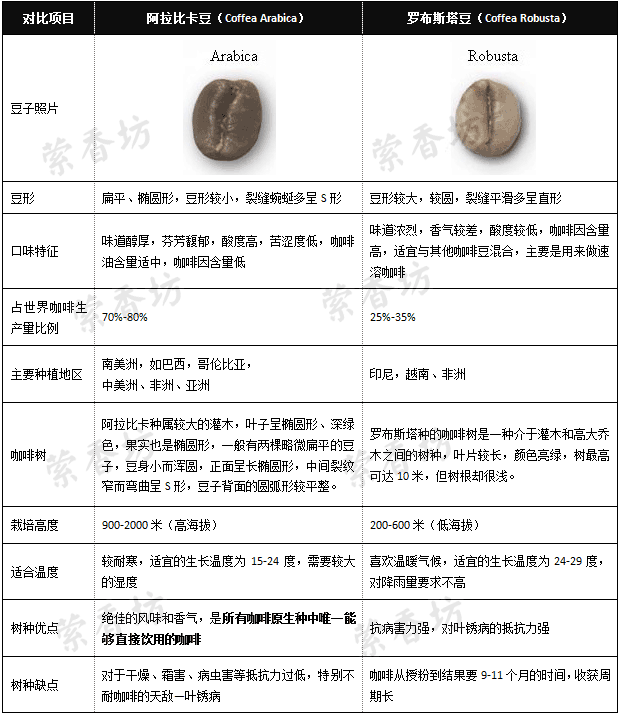The difference between Arabica and Robusta coffee beans
The difference between Arabica and Robusta of coffee beans
Coffee beans come from two main types of coffee trees: Robusta and Arabica. Drinks with high caffeine will come from Robusta, Coffea canephora robusta variety and Elaraby plus Coffea arabica are common beans used by ordinary coffee bean manufacturers, and the taste of the two coffee beans will be different with different proportions.
And what are the characteristics of these two kinds of coffee beans?
Robusta grows in an area with an altitude of 0800 meters, a temperature of 1836 ℃ and an annual precipitation of 2200-3000 mm. From flowering to fruit ripening for about 7-9 months, its bean line is round, with weak wet aroma (aroma) and woody (woody). The coffee produced has a strong bitter taste and low sour taste. Its caffeine content is 1.8 ~ 3.5%. Robota beans have a single taste and strong bitterness, so they are not tasty enough. They are generally used in instant coffee, canned coffee, liquid coffee and other industrial coffee, and a small part of them are used to prepare Italian concentrated mixed beans. It can improve the mellowness of Italian espresso.
Elaraby grows in an area with an altitude of 600-2200m, a temperature of 15 °- 24 °C and an annual rainfall of 1200-2200mm. From flowering to fruit ripening for about 7-9 months, its bean shape is long and has a strong and round wet aroma. The coffee made from Arabica coffee has strong complex flavors such as flowers, fruit, chocolate and caramel. The bitter taste and sour taste of the coffee are well balanced. Its caffeine content is less than 1.5%. Arabica beans are rich in aroma and taste, and taste softer and palatable. Therefore, it occupies a major position in the market. The caffeine content is about 1.5%.
Thus it can be seen that the beans chosen for good coffee should be Arabica, but only Arabica is too general. Arabica coffee can also be good or bad due to differences in geographical location, growing environment, and planting methods.

Important Notice :
前街咖啡 FrontStreet Coffee has moved to new addredd:
FrontStreet Coffee Address: 315,Donghua East Road,GuangZhou
Tel:020 38364473
- Prev

The species of Arabica beans, the classification of Arabica beans, coffee beans, Arabica.
Variety editor native species in all coffee production, Arabica coffee accounts for 70% of the coffee 80%, its excellent flavor and aroma make it the only coffee that can be drunk directly. However, its resistance to dryness, frost, diseases and insect pests is too low, especially the natural enemy of coffee-leaf rust, so all producing countries are committed to variety improvement.
- Next

The brewing principle of hand-brewed coffee the brewing method of coffee how to make coffee tastes good
Hand-brewed coffee is a favorite extraction method in Japan. Hand-brewed coffee is a method invented by a German, and now coffee pot filter paper is sold everywhere in supermarkets, which is the brand founded by the German at that time. To put it simply, the method of hand-brewing coffee is to grind the coffee and put it in a funnel and pour hot water on it.
Related
- Beginners will see the "Coffee pull flower" guide!
- What is the difference between ice blog purified milk and ordinary milk coffee?
- Why is the Philippines the largest producer of crops in Liberia?
- For coffee extraction, should the fine powder be retained?
- How does extracted espresso fill pressed powder? How much strength does it take to press the powder?
- How to make jasmine cold extract coffee? Is the jasmine + latte good?
- Will this little toy really make the coffee taste better? How does Lily Drip affect coffee extraction?
- Will the action of slapping the filter cup also affect coffee extraction?
- What's the difference between powder-to-water ratio and powder-to-liquid ratio?
- What is the Ethiopian local species? What does it have to do with Heirloom native species?

